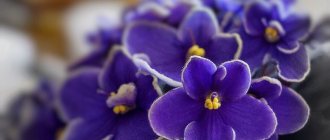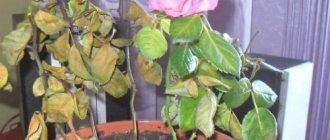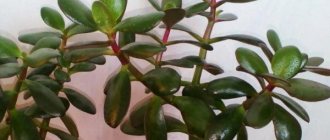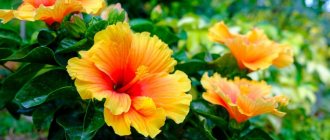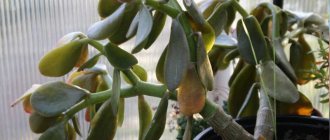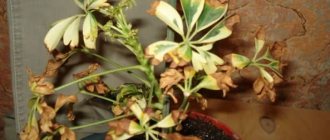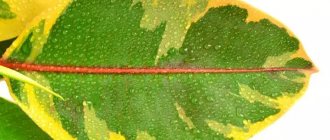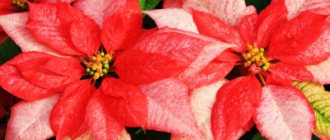Money Tree December 18, 2016 3569
Home » Houseplants » Cacti and succulents » Money tree
Money tree, Crassula, Crassula, which are now often found in any interior - home and office, have gained popularity for their rare unpretentiousness, medicinal properties and beauty. However, often lovers of indoor flowers are forced to ask the question - why do the leaves of the money tree fall? What is the cause of this scourge, how to deal with it?
Why are the leaves falling off the money tree?
Loss of leaves in Crassula is the most common problem in its cultivation and maintenance. The most common reasons:
- the watering regime is disrupted;
- excess direct sunlight;
- overfeeding with mineral fertilizers;
- unsuitable water for irrigation;
- sharp fluctuations in daily temperature;
- diseases, pests;
- the natural aging process of the money tree.
Important! The leaves of the money tree also fall when it is preparing to put out a new branch instead of a leaf. In this case, there is nothing to worry about, as well as with the loss of lower leaves on the trunk.
Frequent or excessive watering, or a combination of both, is the most common reason. Crassula is a succulent in which nature itself provides for abstinence from abundant moisture supply to the roots. Excess water can cause root rot. Drying out roots is less harmful to the money tree.
When overwatered, the fat plant simply sheds its leaves, as if getting rid of water ballast. And if it lacks moisture, the leaves begin to wither, lose their elasticity and fall off.
Excessive direct sunlight for the light-loving Crassula can also cause leaf fall. This is especially important in the summer, when the tree often goes to “rest” in the open air. This is due to the fact that the leaves of the money tree heat up, their tissues lose their elasticity and vitality.
A somewhat rarer cause of leaf fall is excess mineral fertilizers. The increased salt content in the soil, which is a consequence of overfeeding, leads to disruption of metabolic processes in the plant.
Unsuitable water for irrigation - that is, cold water straight from the tap - also harms the fat plant. Cold water is poorly absorbed by the root system, which is why it stagnates in the substrate. Unsettled tap water contains chlorine, which is poisonous to plants.
Sharp fluctuations in daily temperature become a source of stress for the plant, to which the money tree reacts by dropping its leaves.
Important! The money tree is equally harmed by both very low and very high temperatures.
Crassula is extremely resistant to diseases and pests, however, systematic violation of the rules of care weakens the plant and reduces its natural immunity.
With good care, a money tree can live for more than 20 years, but it ages just like all living things.
Tips for caring for this Succulent at home when sick
Crassula, which is in quarantine, needs special attention. In order not to worsen the condition of the plant, follow a few simple rules:
- Adjust watering.
- Protect the flower from sudden changes in temperature and drafts.
- Provide the Crassula with bright lighting, avoiding direct sunlight.
- If pests are identified, inspect the plant regularly. This will help you notice re-infestation in time.
- Temporarily stop introducing fertilizers.
Despite the fact that Crassula is a plant with excellent immunity, it is important to understand that this does not give it 100% protection. That is why the gardener must know what he may encounter when growing Crassula and understand what to do if a particular problem is identified.
What to do to prevent leaves from falling
Strict adherence to the watering regime. In the summer, you need to water your indoor money tree flower daily, but in moderation. In the fall, watering is gradually reduced, reducing it to once a week by the beginning of winter.
This regime is maintained until the beginning of spring, when the plant resumes active growth. Then watering begins to gradually increase.
If the money tree is located near a south window, it needs shading on hot days. If you take it out into the open air in the summer, you need to choose a place so that after 11 o’clock it is in the shade.
To ensure that feeding of the fat plant does not turn out to be excessive, you need to carefully study the instructions for fertilizers and apply them in strict accordance with the instructions.
Water for watering the money tree should sit for at least a day and be at room temperature. The ideal water for irrigation is soft. It is better to boil tap water that is too hard.
To avoid sudden changes in daily temperature, you need to take a responsible approach to choosing a location. The fat woman does not like drafts or heat from heating appliances. Situations often arise when one part of the pot is exposed to the cold from the window, and the other suffers from the heat of the radiators.
Important! If such situations cannot be avoided, it is necessary to provide protection from hot and cold air flows - light screens made of thick paper, cardboard or foam.
Unfortunately, it is impossible to prevent the aging of the money tree. It is possible only at the first signs of its manifestation (falling leaves, cessation of flowering, softening of the trunk) to take measures to rejuvenate it.
Red leaves of Crassula
Reddening of the foliage of a decorative indoor flower may indicate the negative impact of too much sunlight. Despite their tropical origin, almost all types of Crassula cultivated in indoor floriculture do not tolerate prolonged exposure to the sun.
Reddish coloring of the foliage may appear as a result of moving the flower pot with the plant to a more illuminated place. In this case, it is recommended to spill the soil of the flower pot with a solution based on Epin, diluted at the rate of a couple of drops per glass of water. If redness is observed on the underside of the foliage, then it is necessary to adjust the irrigation regime in order to prevent the earthen ball in the flower pot from drying out.
Why do the leaves become limp and fall off?
In addition to the main reasons for the loss of leaves on the money tree described above, there are several more that are directly related to the characteristics of caring for the plant at different times of the year.
In summer, the money tree must be protected from the scorching sun, drying out of the soil and too dry air, drafts and overheating of the substrate in the pot. It should be watered daily, moderately, in the evening, removing excess moisture from the pan.
In the fall, it is important to bring the money tree indoors in time. Night cold temperatures below 10ºC can cause hypothermia of the root system, which can cause disease or stress.
In winter, you should not place a money tree near heating appliances. In the short days of late autumn and until mid-winter, the plant needs additional lighting. The optimal length of daylight for a money tree is 10-12 hours; based on this condition, it is provided with additional lighting.
Another winter problem is dry indoor air. Although the fat woman is indifferent to humidity, once a month she will benefit from a small warm shower.
Important! From mid-autumn until spring, the money tree is not fed. Fertilizing during this period can also cause leaf fall.
There are a number of other problems that lead to the leaves of the fat plant falling off, but they relate to the plant’s habitat.
Money tree is an energetically powerful plant. It is strongly connected with its owners, often falling ill with them. Therefore, it often happens that the tree begins to wither if one of the household becomes seriously ill.
If the money tree is kept under normal conditions and its care is carried out “according to the textbook,” experienced flower growers advise paying the owners’ attention to their own health.
Often, exacerbations of chronic diseases of family members have a negative impact on the plant: it grows poorly, the leaves wither and fall off. Here it is not the plant that needs to be treated, but people. With the recovery of the owners, the money tree quickly comes to its senses.
Also, the energetic connection between the fat woman and family members is clearly expressed when conflict situations arise. If quarrels, scandals, and conflict situations often occur in the house, the money tree, like a tender young lady, begins to mope, expressing its protest by dropping leaves. And in this case, it is not the plant that needs help, but people. When home calm and peace are restored, the tree will also be restored.
Falling leaves
This phenomenon can be caused by several reasons. The succulent reproduces with the help of leaves. If leaves fall in small quantities, there is no need to worry. This is a natural process that does not require any special actions.
Breeding period
Crassula is capable of shedding completely healthy green leaves, which then take root on their own. This is the tree's natural way of propagating.
As a rule, this period begins in the spring, when the plant emerges from its dormant period. But leaves can also fall in small quantities at almost any time. In this case, there is no need to worry.
Winter
In order for the tree to survive the winter safely, it must be moved to a cool room and provided with moderate moisture. At this time, the flower is resting. During the cold season, there is practically no growth of new leaves, but the roots are actively developing.
In winter, you will not have any difficulties with crassula if you follow the following tips:
- transplant before or after the onset of cold weather;
- to extend daylight hours, use fluorescent lamps;
- the optimal temperature for a safe winter is within + 12... + 15˚С;
- water no more than twice a month;
- if the pot is on a windowsill under which the battery is located, place it on foam plastic (the device will help protect the root system from overheating);
- To regulate air humidity, use household humidifiers.
Money tree leaves wither reasons
The situation when the leaves of the money tree become limp and wrinkled is not much less common than its fall. This can be caused by several reasons:
- Excessive watering. The most unpleasant thing is that when overwatering, the root system of the money tree suffers significantly: it begins to rot. Even worse, the leaves become limp only when the rotting process has already begun.
- Inappropriate pot. In a cramped pot, the root system does not have the opportunity to fully develop, which immediately affects the condition of the plant. It is also undesirable to have a container that is too large, since this creates a threat of excess moisture in the substrate.
- Violation of containment conditions. Limp and wrinkled leaves of a money tree are a sign that it suffers from either frequent drafts or lack of light. On the other hand, prolonged exposure of the fat plant to the bright sun in the hot summer also leads to wrinkling of the leaves.
Important! Often, when the leaves become lethargic, inexperienced indoor plant lovers wonder: how to feed the fat plant? There is only one answer: it does not need additional feeding; rather, on the contrary, it can cause even more harm to the plant.
Why do the leaves turn yellow?
Yellow leaves of the money tree are a signal that it does not have enough light. Crassula needs bright, diffused light, so it is recommended to place it near windows that face east, south or west.
If this is not possible, and also in conditions of short daylight hours in winter, the plant needs additional lighting. In addition, yellowing of the leaves is an almost constant companion to the most common problem with the money tree - leaf drop.
Damage by plant parasites
The most common pests in indoor floriculture that attack the “money tree” are mealybugs, spider mites and scale insects:
- When attacked by scale insects, yellowish or brownish-brown raised spots appear on the surface of the foliage. Detected adult plant parasites can be removed from the ornamental crop manually, after which the above-ground part of the plant is treated with a soap solution. In case of massive damage to the fat plant, the stem part and leaves are sprayed with “Fitoverm” or “Fufanon”;
Signs associated with falling leaves
It is generally accepted that the falling leaves of the money tree certainly mean impending losses - material, moral, and in terms of health.
There is another opinion. If you look closely at the dry fallen leaves of the money tree, they will look like slightly dusty gems. This similarity is recommended to be used as a very powerful talisman to attract money. Dry leaves are collected and placed in a special bag, which is kept in the wallet.
Before you accept any sign for yourself as the most likely, you still need to remember that this phenomenon - leaf fall - is just a way for the money tree to reproduce in natural conditions and grow - in the place of the fallen leaf, a bud soon appears, from which it develops new escape.
How to save a money tree
Whatever problem arises with the leaves of the money tree, the very first action should be to restore normal conditions for its maintenance and care.
Important! All problems that may arise when growing a money tree are primarily associated with violation of the rules for caring for it.
Most often, when normal conditions are restored, the fat woman completely returns to normal after one and a half to two weeks. But in severe cases, special measures must be taken to restore the plant to a healthy, beautiful appearance.
If the money tree has suffered from excess moisture, stop watering until the soil is completely dry, and then begin to water very moderately, gradually increasing it to normal. The norm for Crassula is watering once every one or two days in the summer, and once a week in winter.
In advanced cases, when the roots have begun to rot due to excess moisture, only replanting the money tree will help. In this case, you need to carefully shake off the old soil from the roots, let them dry a little and carefully inspect them.
All rotten and broken roots must be cut with a disinfected tool, and the sections should be sprinkled with crushed charcoal or cinnamon powder. If the money tree sheds its leaves due to insufficient moisture, the situation can be easily corrected by restoring normal watering.
Important! It is unacceptable to “help” the plant by watering it beyond the norm.
If excess fertilizer is applied, the plant must be transplanted into fresh substrate. The best would be specialized soil for cacti and succulents. To subsequently avoid the threat of substrate salinity, as well as to prevent the appearance of rot, a small amount of crushed charcoal is immediately added to it. The drainage layer must be at least 2 centimeters thick.
To eliminate the consequences associated with exposure to direct sunlight, it is enough to move the plant to a shaded place. If this is not possible, during especially strong sun hours it should be shaded using any available means - from a newspaper to an ordinary umbrella.
sunburn on money tree leaf
In winter, the money tree pot should be kept away from heating appliances. You can also block it from the flow of hot air. It will be useful to lightly spray the fat plant with warm water once a week.
Money tree pests and how to deal with them
There are a lot of pests that can cause damage to the money tree. However, they are reluctant to deal with a healthy plant. But if the tree is not cared for correctly, it can quickly become a victim of insects.
Most often, a weakened fat woman is attacked by:
- mealybugs, mealybugs and rootbugs;
- scale insects and false scale insects;
- spider mite and greenhouse mite;
- nematodes, thrips and aphids.
Mealybug, a sap-sucking insect, 3-5 mm in length, usually lives in the axils of leaves. It can also be recognized by its powdery white cocoon, in which the female lays eggs.
The usual method of control is to manually remove insects using a stream of warm water and then wipe the plant with a vodka infusion of garlic or calendula. You can also use chemical insecticides, Actellik or Fufanon. Treatment is carried out weekly for 5-6 weeks.
The root mealybug is a more dangerous parasite because it settles in the ground - on the roots and root collar. From one plant, a root mealybug can spread into neighboring pots, because with abundant watering, it crawls out of the pot through the drainage holes and looks for a new victim. Since it lives in the ground, it is difficult to detect.
Important! When replanting a money tree, you need to carefully inspect its roots in order to detect the presence of a pest in time.
The safest way to combat it is to rinse the roots of the plant under a strong stream of warm water. Treatment with Fufanon (0.1%) or Actellik (0.2%) is also suitable. To do this, every 5-7 days the soil is thoroughly watered with an insecticide solution. The procedure is carried out at least five times.
Scale insects and false scale insects are also sap-sucking pests. It is not easy to recognize them, since the color of their shield often matches the color of the trunk or leaf. The fight against scale insects is difficult, since their shield can withstand almost all chemicals.
Therefore, it is usually scraped off by hand, and then the plant is treated with vodka infusions of garlic, celandine, and pine needles. A good effect is obtained by washing the affected areas with kerosene, as well as laundry soap, zoo shampoos, and strong dishwashing detergents (such as Ferry Platinum).
In cases where home remedies do not help, use insecticides that are safe for use in enclosed spaces - Actellik, Fufanon, Arrivo, Karate. Treatment is carried out at least 6-7 times with an interval of 5-7 days.
Spider mites and greenhouse mites most often settle on young leaves and shoots, since they have thinner skin. The condition for their spread is increased dry air. Mites infect a plant very quickly, and in most cases “break” its decorative form.
If this pest is detected, you urgently need to increase the air humidity, spray well or pour cold water over the entire plant and its neighbors. Homemade, natural remedies that help get rid of ticks include infusions of yarrow or chamomile, garlic or onions, tobacco or potatoes. From chemical agents, preparations and means of combating scale insects are suitable.
Nematodes are filamentous worms that parasitize on roots, forming swellings on the latter - galls. Outwardly, damage by nematodes does not affect the plant, but their presence indicates a slowdown and sometimes cessation of tree growth.
If swelling on the roots is detected during transplantation of the money tree, the damaged roots are cut to the base. You can also use the medical anthelmintic drug Pirantel. Make a solution (250 grams per 10 liters of water) and water the affected plant generously twice with an interval of two weeks.
In advanced cases, it may be easier to re-cut the money tree.
Thrips, also classified as sap-sucking pests, are also capable of transmitting viral diseases, so they are currently considered the most dangerous of the pests. Typically, their massive accumulations occur during the flowering period, when they penetrate the buds. After the money tree blooms, they move to its lower parts.
Home remedies in the fight against thrips are in most cases useless, so you have to turn to chemicals for help: Actellik, Fufanon, Tsimbum, Karate. You can use Fitoverm.
Aphids usually end up on the property along with street soil or from neighbors, acquired second-hand. In places where aphids accumulate, the leaves and twigs of the fat plant usually wrinkle and bend, often dry out and fall off.
The best way to control aphids is to wash the plant with green soap or other strong detergents.
What to do if it dries out?
Leaf plate
To prevent the leaf blades from drying out, keep the soil moist in the pot! The soil should not be very wet. It is impossible for water to remain in the pot or its bottom after watering. But don’t let the soil dry out! It is enough to water Crassula once a week in the summer, and once every two weeks in the winter.
But you should take into account the conditions in which the money tree lives in your place - temperature, humidity, solar activity, heating. It is better to focus on the condition of the plant and simply check the soil moisture from time to time. The fat woman does not like direct sunlight. Therefore, in summer it is better to shade the plant or remove it from southern windows.
Leaves that have fallen from the heat grow back after a while, but it is better to avoid such untidy moments.
Whole plant
When the fat plant is damaged by pests or diseases, the entire plant begins to wither. “Enemies” can be detected by careful inspection.
- Powdery mildew resembles a whitish coating on leaves with a musty smell.
- Fusarium rot covers the roots and basal part of the plant with a pinkish coating, the plant becomes flabby and lethargic.
For money tree disease, there are 2 options:
- Transplant into new soil and a new pot.
- Wash the old pot well with soap and scald with boiling water. Wash the plant itself with warm water. Then treat, including the roots, with Fundazol or Fitosporin.
Pests can also be identified visually:
- Scale insect - small brown spots appear on the leaves.
- Spider mite - the affected leaves are covered with a brown crust, you can also see the bugs themselves, white and red.
- The mealybug is the most easily recognized enemy of the Crassula - formations resembling cotton wool or poplar fluff are visible on the leaves and in the axils.
To control pests, use the following products:
Aktara.- Fitoverm.
- You can spray the plant with infusion of tobacco dust or garlic.
- Wash the leaves with soapy water, then rinse with clean water.
- To combat scale insects and mealybugs, wipe the leaves with alcohol or kerosene.
Replanting a plant is an excellent way to help a plant when it is damaged by pests or diseases , as well as when the roots rot due to improper watering.
- If there are dead roots, they are cut off. The sections are treated with crushed carbon (you can take activated carbon tablets from the pharmacy).
- It is better to plant Crassula in a mixture of leaf or turf soil, peat, and sand. Mixing proportions 1:0.5:1.
- Good drainage of 2-3 cm at the bottom of the pot is important; expanded clay or broken brick will do.
- The pot should have a hole at the bottom.
Money tree diseases and how to treat them
Most often, the money tree is affected by bacterial and fungal infections. Moreover, they usually appear in winter due to short daylight hours and low air temperatures.
Fungal diseases caused by the pathogens Biotytis cinema, Phytophtora and Fusariun (various rots) usually begin their spread from the root collar and in a fairly short time affect the entire plant. As a rule, these spots are brown-brown in color, at first single and small, then increasing in size and frequency of occurrence.
Important! If treatment is not started in time, it is better to prune the money tree radically, leaving a few healthy cuttings.
If the disease is noticed in time, the following measures are taken:
- reduction of watering;
- increased ventilation;
- removal of affected areas;
- disinfection of sections.
As a preventive measure, the money tree is usually watered with a weak solution of potassium permanganate two or three times a year.
Bacterial diseases of Crassula are practically indistinguishable in appearance from fungal diseases. It is impossible to determine them at home, since this requires special equipment.
Bacterial diseases of Crassula
However, both bacterial and fungal diseases of the money tree can be treated with fungicides and available antibiotics (penicillin) by spraying them with aqueous solutions.


